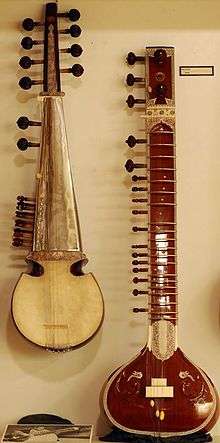Saptak
Saptak means "gamut" or "the series of seven notes". It denotes the set of swaras i.e. Ṣaḍja (Sa), Ṛiṣabha (Re), Gāndhāra (Ga), Madhyama (music) (Ma), Panchama(Pa), Dhaivata (Dha), Niṣāda (Ni) which comprise a musical scale in Indian classical music. In Sanskrit, saptak literally means "containing seven" and is derived from the Sanskrit word Sapta which means "seven".
The basic saptak is called the Madhya Saptak (Devanagari: मध्य सप्तक). For notes with lower frequencies, the artist may use the Mandra Saptak (Devanagari: मंद्र सप्तक)', which is a lower octave than the Madhya Saptak. For notes with higher frequencies, the upper octave or the Taar Saptak (Devanagari: तार सप्तक) is used.
The usual scale of Indian music spans from Sa in the Madhya Saptak to Sa in the higher, Taar Saptak. This inclusion of the first note of the higher saptak makes eight notes instead of the seven in each Saptak.[1]
Generally, a raga involves notes from three saptaks. The notes in the lower octave are denoted by an apostrophe before the note representation (or a dot below the note representation) and the notes in the upper octave are denoted by an apostrophe after the note representation (or a dot above the note representation).
For example:
- Mandra Saptak : Ş or 'S
- Madhya Saptak : S
- Taar Saptak : Ŝ or S'
Talking about frequencies of the svaras, the frequencies change for all svaras i.e. Sa 240 Hz, Re 270 Hz, Ga 300 Hz, Ma 320 Hz, Pa 360 Hz, Dha 400 Hz, and Ni 450 Hz. Consequently the Sa after the Ni of 450Hz has a frequency of 480 Hz i.e. the double of the Lower octave Sa and does all the other 6 svaras.
Considering the Sa of the Madhya Saptak then frequencies of the other svaras will be,
Sa Re Ga Ma Pa Dha Ni Mandra Saptak: 120 Hz, 135 Hz, 150 Hz, 160 Hz, 180 Hz, 200 Hz, 225 Hz.} Madhya Saptak: 240 Hz, 270 Hz, 300 Hz, 320 Hz, 360 Hz, 400 Hz, 450 Hz.}Frequencies Taar Saptak: 480 Hz, 540 Hz, 600 Hz, 640 Hz, 720 Hz, 800 Hz, 900 Hz.}
